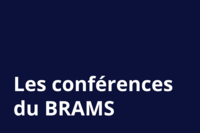From Social Physiology to Social Neuro-AI: How Multi-Brain Neuroscience can inform Artificial Intelligence and Computational Psychiatry?
Dr. Guillaume Dumas, Université de Montréal
- Université de Montréal, Pavilion Marie-Victorin, Room D-427 : Please register via the Doodle link.
- The lecture will also be available via Zoom. No registration is required. Meeting ID: 892 1607 9722 Passcode: 862683
- The lecture will also be streaming live on Facebook.
- Please note that the conference will be recorded and available on Facebook immediately after the conference. A link to BRAMS YouTube will be added to the BRAMS website page for the conference, as soon as available.
Abstract: Cognitive sciences have approached social cognition from two complementary perspectives. On one hand, social psychology and behavioural economics have mostly emphasized mentalizing, social perception, and our ability to model other minds. On the other hand, developmental psychology and motor neuroscience have more focused on imitating, social interaction, and our propensity to coordinate with others' behaviour. This polarization leads to a " chicken-egg paradox " regarding the origin of social cognition in humans: while the former claim that we need to model others to interact with them; the latter argue that we first need to interact with others to model their minds. Those two perspectives are on top operating at different levels of explanation with different conceptual and mathematical formalisms. For instance, while social computations during offline economic games are very well captured by Bayesian statistics, social coordination during sensorimotor coupling is better modelled using dynamical systems. In this talk, I will illustrate how we can operationalize a " social physiology " modelling human cognition as a multi-scale complex system that interfaces biological and social processes. The term " physiology " was introduced by Claude Bernard not as a medical subfield but rather as a systemic and integrative posture towards biological functions (1865). Here, we will expand this posture by including social functions as well, using experimental approaches in both real and artificial agents. We will start with multi-brain neuroscience and how inter-brain connectivity provides a quantitative marker for bridging the gap between intra-personal mechanisms and interpersonal dynamics. Then, we will continue with neuro-inspired artificial intelligence and how the observations initially described in interactive social neuroscience can inspire architectures for virtual avatars and machine learning algorithms. Finally, we will discuss the case of mental health and how such a social physiology is inevitably calling for the development of computational psychiatry beyond the boundaries of individuals' skulls.
Bio: Guillaume Dumas is an Associate Professor in Computational Psychiatry at the Faculty of Medicine at the University of Montréal and the Director of the Precision Psychiatry and Social Physiology laboratory at the CHU Sainte-Justine research center. He holds the IVADO Chair in "AI and Mental Health", the FRQS J1 fellowship in "AI and Digital Health" and is an appointed academic member of Mila - Quebec Artificial Intelligence institute. He is internationally recognized for his research on the neural bases of social interaction through multi-brain neuroscience. Dr. Dumas has co-created the first graduate course in computational medicine in French at Université de Montréal. He also participates in numerous projects at the interface between science and society, from raising awareness about open science (co-founder of HackYourResearch) to advising governments about AI (expert for the two French AI national strategic plans) and fighting for cognitive freedom (twice invited expert at the United Nations Human Rights Council).
